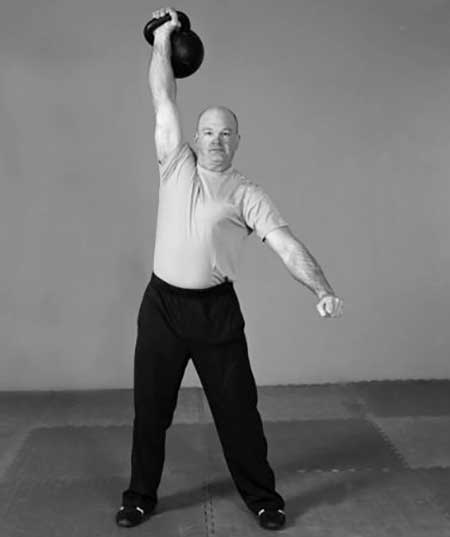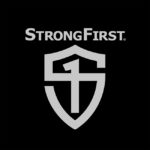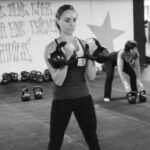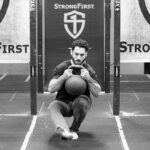I was asked a question the other day: “What is the go-to kettlebell exercise for martial conditioning?” Well, pick your poison; you really couldn’t give a bad answer.
- Are kettlebell swings good for the martial artist? Uh, yeah!
- Or could you argue against the get-up? No, not really, there are a ton of benefits hidden inside a get-up.
- What about the snatch? Certainly the Tsar of the kettlebell world would be a great addition to any martial arts training regimen.
Like I said, pick any of these and you would be correct, but what if you found yourself on the proverbial desert island of exercise and could only choose one kettlebell movement to keep in your training quiver. The answer is easy. The one-arm clean and jerk.
The One-Arm Clean and Jerk
Yes, you need a solid strength foundation and the best way to get that is a steady diet of deadlifts and presses a la Pavel’s Power to the People!, but the one-arm clean and jerk is the one-stop shop for martial conditioning.
Inside the clean and jerk lives a swing, a press, and a bit of a squat. Give me ten minutes and one kettlebell, and I will give you power, stamina, resilience, and mental toughness all in one tidy package. It’s all about legs and lungs, guys, and if you follow this to the letter that is exactly where you will feel it. After hard work on the clean and jerk, everything else will feel like a party.

Before we go any further I need to clarify something. I am talking about long cycle clean and jerks, and you need to re-clean the kettlebell between every rep.
What I am not suggesting is a girevoy sport type ten-minute set. Girevoy sport is the term for sport kettlebell competition where the object is to get as many reps in ten minutes as possible without setting the bell down. A manly effort for sure, and a sport full of great athletes, beyond a doubt. If this is what suits your fancy, more power to you. But my goal and the goal of the martial artist goes beyond the kettlebell. We are just using the kettlebell as a means to an end (shh, don’t tell my kettlebells).
How to Program the Clean and Jerk for Martial Conditioning
First, get your clean and jerk technique down pat, and to do this it is critical that you work with an SFG Level II instructor. They have specialized training in the clean and jerk, and they can shortcut your learning by taking much of the trial and error out of your way. There is a time to be cheap and a time to be smart. Be smart and hire a coach.
Once you have your form dialed in, you must go heavy. In this case “heavy” means a kettlebell you can clean and jerk for about 7 to 8 reps. A 32kg kettlebell would be a good place to start for men. If you can’t do this with at least a 24kg, then stop and get strong first.
Now, take a ten-minute test. See how many clean and jerk you can do. You can switch hands whenever you like and you can set the kettlebell down whenever you like, but you are fighting the clock.
If you get more than 120 reps, then you used a kettlebell that was too light, shame on you! On the other hand, if you could only do 50 or 60 reps, you chose too heavy. I would be happy with a score of about 80 to 90 reps. We are after the Goldilocks kettlebell—not too heavy, not too light, but just right.
Now, here is how we train:
- At your next practice, set a timer to count down ten minutes. You want it to beep at you every minute.
- Using your Goldilocks kettlebell, do 5 clean and jerks with your right arm, then switch and do 5 with the left.
- Rest for whatever time is left of the minute.
- Repeat at the top of every minute for 10 minutes.
If you can keep up the pace, at the end of ten minutes you will have done 100 total reps. What most people find is that at about the seven to eight minute mark things start to get ugly. If you need to drop your rep count to four and four or even three and three, go ahead. You must keep excellent form and you may not fail.
Note: By the way, it is important to keep an accurate track of your reps, so figure out some way to do this on the fly. Many of my students just make a mark on a white board during the rest. 5 right and 5 left gets one tick mark. Ten tick marks equals 100 reps.
We can program our training very easily now:
- The hard day pace is 5-5 (100) reps. We will call it 100%.
- On medium day, the pace is 4-4 (80) reps, or 80%.
- One easy day, the pace is 3-3 (60) reps, or 60%.
- Test Day is 6-6 (120) reps, or 120%.
Set the training week to go like this:
- Monday = Hard
- Wednesday = Easy
- Friday = Medium
About once a month swap out your hard day for a test day. If you can successfully make 6-6 every minute on the minute for ten minutes, then you have earned the right to move on to a heavier kettlebell.
What About the Two-Arm Clean and Jerk?
Okay, I see a hand going up in the back of the room. You are wondering if the one-arm clean and jerk is so great, then wouldn’t the two-arm version be twice as good? The answer is, yes and no.
Yes, you can move twice the weight in half the time and that is good, but you need to have better than average shoulder mobility to safely do the two-arm version. Most fighters do not. Should we aim to improve shoulder mobility? Sure, but that is the icing on the cake, not the main event, and if you try to make correctives the main event, you will starve as a trainer.
The one-arm version will let us work around shoulder mobility for now and, to be quite frank, there is no compelling reason for a fighter to do double clean and jerks. Remember, kettlebell training is not their sport, just a means to an end.
The second reason I like the one-arm version better is that you can rest one arm while the other works. If you can call that rest—even though one arm is just along for the ride, the legs and lungs are still smoking away. The one-arm clean and jerk allows us to prolong the agony.
There it is. You will find that you really do not need or want much more. Plug this in after your technical martial arts training and stop wasting time in the gym. You can have your conditioning and a life at the same time. Just give me ten minutes and I will make you a man.
Jon Engum, StrongFirst Certified Master Instructor, is a certified Martial Arts Grandmaster. He currently holds a 7th Dan black belt in Taekwondo, a 4th Dan black belt in Hapkido, and a 4th Dan black belt in Kumdo. Engum is a StrongFirst Certified Master Instructor, SBS, CK-FMS, and author of “Flexible Steel, an Insider’s Guide to Ultimate Flexibility.” His website is Extreme Training.





Jon,
I was actually in the process of writing an article just like this when i stumbled upon your article.
Im glad im not the only one who was thinking like this. Playing around with RTK protocol, i found a single bell jerk with a top of the min ATG-esque programming was very beneficial.
My training partner had been training for a fight coming up later this month, i havent been in the gym. Simply lifting bells in a very similar fashion. My cardio/conditioning level is right up there with his after a full fight camp, maybe a notch under but not by much at all.
Real world testing proof that the long cycle is quite possibly the best for a fighter.
Hank H.
What is gained by doing hand switch with half the reps each side every set? Why not do all reps with one hand and just alternate sets? What is gained/lost either way?
Tried the program but have no rest time left when I do 4/4 or 5/5. Those take entire minute to finish. Am I too slow? I feel like my technique is good. One side per minute could be answer but again, doesn”t accomplish what Mr. Engum is asking for. Any suggestions?
Hi Ron
Yes the same thing with me after 5 reps each side there was like 10 second rest with the 32kg! So it’s basically one continuous set!
I took 1 min between sets and may try to decrease the rest 5 sec per week as conditioning tool.
To be honest I think most people would have the same result and they didn’t really trial it properly before assessing any ‘bugs’.
Doesn’t look like Jon is answering questions here any more. I’d say if you can get the rest to around 20 sec with 6 reps per side then go ahead and try the next heaviest kettlebell with 1 min rest intervals and you’ll be pretty much a beast if you can do 36 or 40 x6 over 10 sets with 20 sec rest!
Cheers
Dave
Dave, please visit our forum and start a new thread to discuss this blog and program. The article was published over 5 years ago. Our forum is located at http://StrongFirst.com/community, or just click on the Forum link via the menus here.
Thank you very much.
-S-
Excellent article. If I had to choose TWO exercises I’d go with the S&S programme, but I’m a long time (mainly) judo guy so I’m thinking about grappling muscles more than striking muscles. For one exercise only, I was thinking clean and press, but clean and jerk makes more sense as it’s explosive. Thank you for an excellent article!
This is fine workout and prepares me pretty well to kettlebell marathon competion also. ?
great article jon one of those simple but not easy practices. Plus it uses OUR techniques in this drill to great advantage: More STRENGTH!
You are not a man until you’ve trained the LCCJ. Brutal.
Great routine for a non-fighter as well! Reading the comments makes me realize that some folks don’t quite understand the words “strength” and “heavy.” You must be StrongFirst!
Thanks Jon!
Just what I was looking for on my conditioning days. Needed something that’s easy on the elbows yet also good for shoulder stability. Was going to do Getups, then Swings, but will get all that I need here… and with a nice challenge built in to boot.
Will let you know how they effect my Wing Tsun after a cycle or two.
Great article! I think the long cycle gets overlooked in hardstyle training. In my opinion it is much more beneficial than swings or snatches. Could possibly be the beast bang for your buck exercise there is.
Great Article!
Jon,
Excellent article and love the idea of this protocol. I’ve become a HUGE fan of the KB C&J and have really dialed in on my technique with lots of practice, building the pattern. Haven’t seen this specific protocol before with the C&J’s, so thanks for sharing. Look forward to testing this one out. I’m thinking this is a “punishing” session with the Goldilocks bell. And, I agree with Chris, Flexible Steel is an excellent book, well done!
Cheers! Scott
Scott thanks for your kind words. Glad you like/hate the training 🙂
John,
Great article. Just getting back into working out myself I am doing nothing but kettlebells and Bodyweight. I am a 5th Degree in Taekwondo myself, 4th Degree in Hapkido and a 4th Degree in Ed Parkers American Kenpo. I have been throwing in the Highland games and training for it, but its not really me. I still plan to throw, but its time to get backto what works for me.
I also plan on trying to teach again toward the end of the year, we will see how that goes :-). Being in Tulsa I may try to get down to your Guthrie OK Seminar in July.
brian ed parker american kenpo is well know for it great hands speed and power how kettlebell help? one of great art out there i seen an american kenpo guy take 2 guys in street once ,they were trying to take his car from his wife at the mall ,those guys went to hospital to E.R.
Noe, American Kenpo is based on science and physics and common sense. Now I grant you it is overly complicated and Ed Parker would have stremlined it by now in my opinion. But it is a very no nonsense, street based self defense art. Add in the ability to defend against a grappler and it is golden.
There is no ‘Best’ Martial art even though the MMA guys think BJJ is the end all. All have positives, all have chinks in the armor. I suggest someone find out what they do best (Kick, strike, take someone down etc) and find an art that best fits their baseline skill set and work it for 5 years. Then address the chinks in the armor of that art AFTER you have spent at least 5 years training in it.
Everyone looks for ‘the best’ when the best is within them selfs if they park ego, be patient, learn then adapt.
Thanks I hope the post helps with all your goals and I hope to see you in Flexible Steel soon!
John, I have found that many of us have neglected a side in some ways. With the barbell and sometimes with dual kettlebells you can kind of BS or cheat your way to getting the lifts done.
I think there is HUGE benefit from doing unilateral training. I think one can get damn strong working split squats with the bells while learning to do pistols, then weighted pistols for leg strength. People from all walks of life regardless of goals needs to spend time doing unilateral work imho. We are only as strong as our weaknesses, so shore them up!
John, this is awesome, I LOVE this type of training. Would you be willing to share an article or point me to one for the shoulder mobility work you do to keep shoulders healthy while also training high volume overhead work?
Love what U do, my friend. Thank you!!!
Z
me too!!!
Peace ~ Bear
Zach – Jerks really don’t bother my shoulders …perhaps because the eccentric load is not to great. Anyway I use armbars and kettlebell pullovers as movement prep. I have discussed these in Flexible Steel and also in a article over at breaking muscle.
What a great post. My initial thought was heresy. As I read on I learned this was not about GS vs HardStyle but about making us the best athletes we can be. I own your latest book, Flexible Steel and its content has accelerated my ability to improve my athletic performance. I hope to see you in NYC in May after I qualify SFG in Boston in April.
Chris thank you for your kind words. If you pull the trigger on the NYC FS today you can get a 2-1. You and a friend can come for the price of one…just email me the name of the second person. Hope you can make it.
Double Viking push press and the swing are my main ballistics, Kotlorx
So David how you compare C&J- Vpp?
Kotlorz, I don’t have anything against the one-arm C&J, but for me personally, i like the VPP because i’m using two kettlebells and feel I get a better overload with the extra weight. I could do double C&J but personally, i don’t like the wide stance i have to use. The swing is the foundation of my workout. So my routine is to swing one day, next day VPP. This article was about one movement only – but as you can see, i’ve simply separated the push and pull workouts on different days.
By the nature of the exercise the VVP is to be done with relatively light weights very quickly. It is easy to cheat and slow down if you are not careful. Heavy Jerks demand snap and power or they fail…no way to cheat it…anyway give the program a try I think you will like-hate it 🙂
What about Viking Pushs?
I prefere VP more then C&J because they are more explesive and agressive- just like in a real fight.